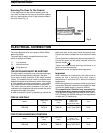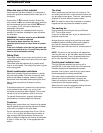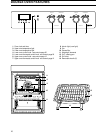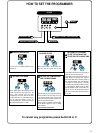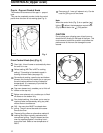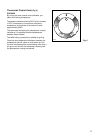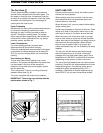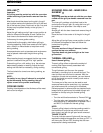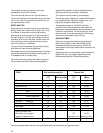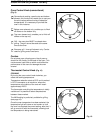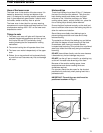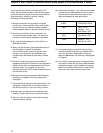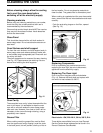
16
USING THE CONVENTIONAL OVEN
CONVENTIONAL COOKING
This function uses the top and lower elements to give
single level cooking.
Position the shelf on the second level for best results.
However, for dishes which require extra base
browning such as pizzas, quiches and flans, lower
the shelf to level one. To increase top browning,
raise the shelf to level three.
• Turn the oven selector control knob to
Conventional Oven .
• Turn the oven temperature control knob to the
required setting.
NOTE:
a) The oven on light will illuminate.
b) The oven temperature light will illuminate.
THINGS TO NOTE
The oven indicator light will glow until the oven has
reached the desired temperature and then go OUT. It
will then cycle ON and OFF showing that the oven
temperature is being maintained.
TOP AND BOTTOM ELEMENTS
Top oven element only
This function is suitable for finishing cooked dishes,
eg; lasagne, shepherd's pie, cauliflower cheese etc.
Bottom oven element only
This function is particularly useful when blind-baking
pastry or cooking pizza.
This oven is supplied with two anti-tip shelves.
IMPORTANT: The anti-tip oven shelf must be
positioned as shown in Fig. 7.
CONDENSATION
Under certain conditions, condensation may form on
the oven. Condensation is quite normal and forms
when moisture and heat is present, e.g. during
cooking. A boiling kettle produces steam and similarly
when food reaches cooking temperature, steam is also
produced which condenses on to the cooler surfaces.
It is not necessarily caused by extremes of
temperature, but as a result of one or more of the
following:
1. The cooking temperatures
2. Temperature of the food when placed in the
oven
3. Moisture present in the food
4. Quantity of food
5. The temperature and ventilation in the
kitchen.
Ideal cooking conditions are not always available but
where possible ensure foods which contain a lot of
moisture, e.g. casseroles, are covered.
Provided that the oven is wiped and dried during or
after cooking, no harm will occur.
HINTS AND TIPS
The material and finish of the baking trays and
dishes used will affect base browning. Enamel-ware,
dark, heavy or non-stick utensils increase base
browning, while oven glassware, shiny aluminium or
polished steel trays reflect the heat away and give
less base browning.
Always place dishes centrally on the shelf to ensure
even browning.
Stand dishes on suitably sized baking trays to
prevent spillage onto the base of the oven and make
cleaning easier.
Do not place dishes, tins or baking trays directly on
the oven base as it becomes very hot and damage
will occur.



